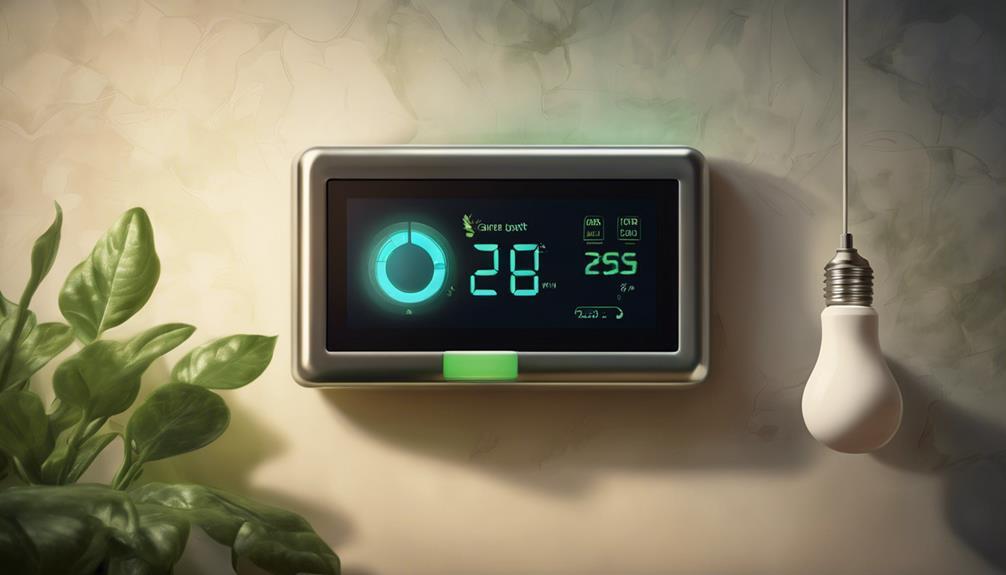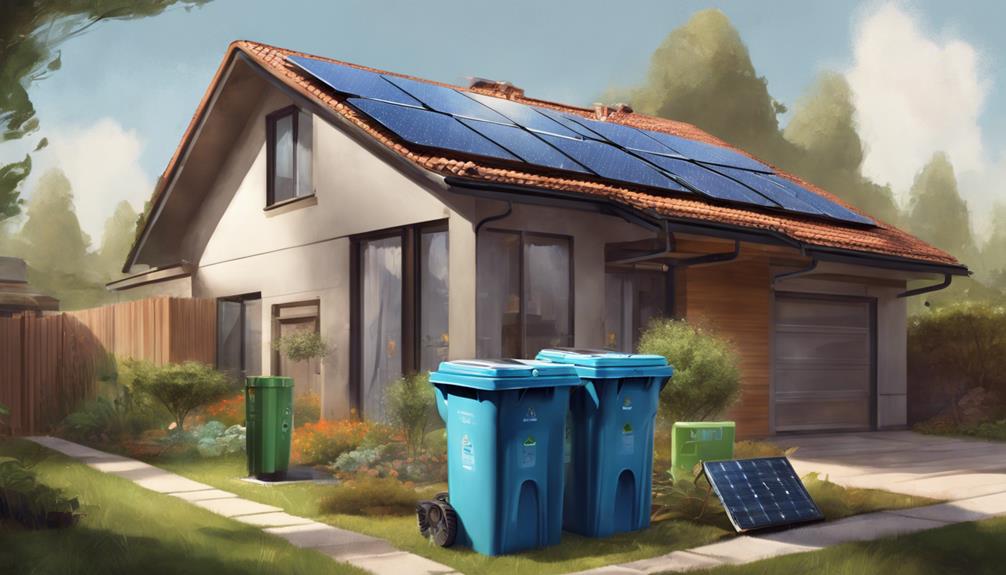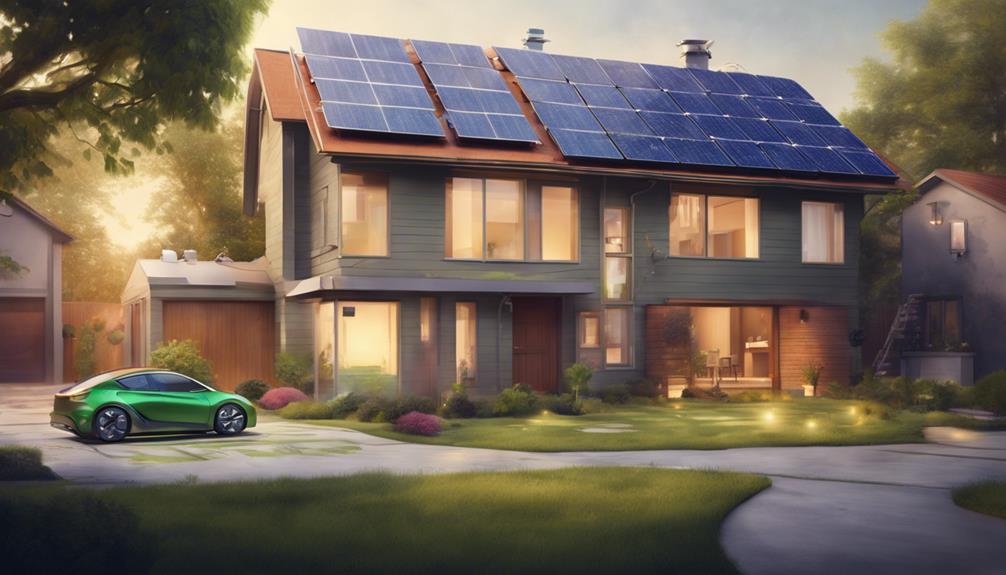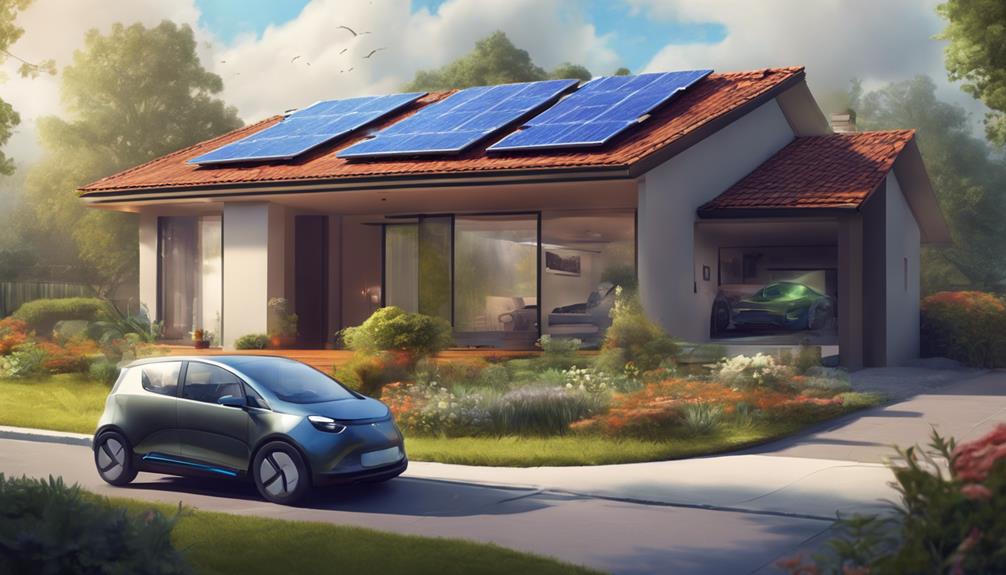Embrace green energy to slash your carbon footprint and lower your bills effortlessly. Upgrade to ENERGY STAR-rated appliances, insulate your home, and invest in renewable sources for significant savings. Adjust your thermostat to 68°F in winter and 78°F in summer to maximize efficiency. Opt for reusable items, utilize cold water for laundry, and maintain vehicle efficiency for further eco-friendly benefits. By taking these steps, you'll witness a positive impact on both your wallet and the environment.
Key Takeaways
- Upgrade to energy-efficient appliances for reduced bills and emissions.
- Implement sustainable transportation practices to lower carbon footprint.
- Use cold water for laundry and line-dry clothes to save energy.
- Seal air leaks and insulate your home for energy savings.
- Turn off lights and unplug devices to conserve energy and reduce costs.
Sustainable Home Energy Practices

To save on energy costs, consider implementing sustainable home energy practices such as using ENERGY STAR appliances and insulating your home. These small changes can make a big impact on your wallet and the environment.
Start by replacing your light fixtures with ENERGY STAR bulbs, which can slash lighting costs by up to 75%. Additionally, using ENERGY STAR appliances not only reduces energy usage by 10-50% compared to standard models but also contributes to a more energy-efficient home.
One smart way to further enhance your energy efficiency is by installing a smart thermostat. This device can learn your preferences and adjust the temperature accordingly, optimizing your heating and cooling systems for maximum savings.
Insulating your home is another pivotal step in reducing energy costs by up to 30%. Proper insulation helps maintain a comfortable temperature indoors without overworking your HVAC system.
Energy-Efficient Home Improvements

Upgrade your home with cost-effective energy-efficient improvements to save money and reduce your environmental impact. Enhancing your home's energy efficiency not only benefits your wallet but also adds value to your property.
Consider making these upgrades to lower your utility bills and contribute to a greener future.
Cost-Effective Energy Upgrades
Consider implementing cost-effective energy upgrades through energy-efficient home improvements to lower your utility bills and reduce greenhouse gas emissions. By making these changes, you can't only save money but also contribute to a healthier environment.
Here are four impactful ways to make your home more energy-efficient:
- Upgrade to Energy-Efficient Appliances: By replacing old appliances with energy-efficient models, you can substantially reduce your energy consumption and save up to $600 annually on utility bills.
- Install Energy-Efficient Windows: Upgrading to energy-efficient windows can help better insulate your home, reducing the need for heating and cooling, and ultimately decreasing your energy costs.
- Invest in Renewable Energy Sources: Consider installing solar panels or a geothermal heat pump to generate your electricity and heat. These upgrades can lead to substantial long-term savings on energy bills.
- Seal Air Leaks and Insulate Your Home: Proper insulation and sealing air leaks can prevent energy wastage, resulting in lower utility bills and a more comfortable living space.
Environmental Impact Reduction
Implementing energy-efficient home improvements can notably reduce your environmental impact while also saving you money on utility bills. By upgrading to energy-efficient appliances, insulation, and windows, you can significantly reduce greenhouse gas emissions, lowering your carbon footprint by up to 4,500 pounds annually.
These improvements not only benefit the environment but can also lead to savings of up to 30% on your energy bills. Investing in proper home energy management systems can further help in reducing your energy consumption by up to 15%.
Home Value Enhancement
To enhance the value of your home through energy-efficient improvements, you can greatly increase its market appeal and potential resale value. By investing in energy-efficient appliances, windows, and other upgrades, you not only make your home more attractive to potential buyers but also reap the benefits of lower utility bills and reduced environmental impact.
Here are four ways energy-efficient improvements can enhance your home value:
- Save Money: Upgrading to energy-efficient appliances and windows can increase your home's value by up to 10%, while saving you up to $2,000 annually on utility bills.
- Reduce Emissions: Energy-efficient upgrades can cut greenhouse gas emissions by up to 4,000 pounds per year, contributing to a cleaner environment.
- Get Incentives: Take advantage of tax incentives and rebates available for making energy-efficient improvements, adding to your savings.
- Enhance Comfort: Enjoy a more comfortable living space with improved energy efficiency and lower maintenance costs.
Home Temperature Control

Optimize your energy usage by setting your thermostat to 68°F in winter and 78°F in summer.
Save up to 3% on your energy bill by turning down your thermostat by just 1 degree.
Learn how programmable thermostats and proper insulation can help you save money on your energy costs.
Thermostat Efficiency Tips
Consider adjusting your thermostat by 7-10 degrees lower for 8 hours a day to maximize energy savings on heating and cooling costs.
Smart thermostats are a great option to efficiently manage your home's temperature and reduce energy bills. Here are some tips to enhance the efficiency of your thermostat:
- Invest in a Smart Thermostat: Smart thermostats can save you up to 10-12% on heating costs and 15% on cooling costs annually.
- Programmable Thermostats: Utilize programmable thermostats to potentially save up to $180 per year on energy costs.
- Small Adjustments Matter: Even a 1-degree adjustment can lead to a 1% change in your energy bill.
- Proper Usage is Key: Properly using a programmable thermostat can result in about 10% savings on your annual heating and cooling costs.
Energy-Saving Temperature Strategies
Enhance your home's energy efficiency by implementing effective temperature control strategies to reduce heating and cooling costs. Setting your thermostat to specific temperatures can reduce energy expenses by up to 10% annually. By turning off heating and cooling systems when you're away, you could save around 10% on your yearly energy bill.
Additionally, lowering your thermostat by 7-10 degrees Fahrenheit for 8 hours daily can lead to savings of up to 10% on heating and cooling costs. Properly insulating and sealing your home is vital, as it can decrease energy expenses by up to 30%.
To further enhance energy efficiency, consider adopting smart temperature control practices. Smart thermostats allow you to remotely adjust your home's temperature, ensuring you're not wasting energy when no one is home. These devices can learn your preferences and create energy-saving schedules tailored to your lifestyle.
Waste Reduction

To promote waste reduction, focus on avoiding single-use plastics and opting for reusable items. Repurposing or recycling items can minimize environmental impact and support waste reduction efforts. By decreasing plastic consumption and choosing products with minimal packaging, you can help reduce landfill waste. Additionally, practicing composting and proper recycling methods can divert materials from landfills, further contributing to a greener environment.
Here are four ways to make a difference in waste reduction:
- Carry a reusable water bottle: By doing this, you can reduce the energy used in producing single-use plastic bottles and minimize plastic waste.
- Use reusable shopping bags: Opting for reusable bags decreases the need for plastic bags, reducing your environmental footprint.
- Invest in reusable containers: Instead of using disposable containers for food storage, choose reusable containers to cut down on waste and energy used in producing them.
- Shop consciously: Select products with minimal packaging to reduce waste and support eco-friendly alternatives, thereby lowering the energy used in creating unnecessary packaging.
Water and Energy Saving

You can reduce your energy consumption by using cold water for laundry and washing full loads.
Line-drying clothes instead of using a dryer can save you up to $100 annually.
Efficient Laundry Practices
How can you considerably reduce your energy and water consumption when doing laundry?
Here are four simple yet effective ways to make your laundry routine more energy-efficient and environmentally friendly:
- Use cold water: By washing your clothes in cold water, you can save up to 90% of the energy typically used for washing. This not only helps reduce your carbon footprint but also saves you money on your energy bills.
- Wash full loads: Opt for washing full loads of laundry as it can save approximately 3,400 gallons of water annually per household. This simple habit conserves water and reduces the energy required for multiple smaller loads.
- Air-dry your clothes: Instead of using a dryer, consider line-drying your clothes. This practice can save around 5.8 kg of CO2 emissions per load and further decrease your energy consumption.
- Upgrade to energy-efficient appliances: Investing in energy-efficient washing machines and dryers can notably decrease your utility bills by up to $100 per year. These appliances are designed to use less energy while still delivering excellent cleaning results.
Energy-Saving Home Habits
Implementing energy-saving home habits can greatly reduce both your water and energy consumption, leading to cost savings and a positive environmental impact.
Simple changes like using cold water for laundry can save up to 90% of the energy used for washing clothes. Additionally, washing full loads of laundry can cut water usage by up to 3,400 gallons per year, contributing to a significant reduction in your carbon footprint. By adopting these practices, households can save up to $100 annually while also supporting Green Energy initiatives.
Another effective habit is line-drying clothes instead of using a dryer, which can save approximately 700 pounds of carbon dioxide emissions annually.
Conserving water and energy not only benefits your wallet but also plays an essential role in minimizing environmental impact. By making conscious choices in your daily routines, you can make a real difference in reducing your carbon footprint and promoting a more sustainable future.
Vehicle Efficiency

Improving your vehicle's efficiency is key to reducing fuel consumption and environmental impact. Here are four essential tips to help you enhance your vehicle's efficiency and decrease your carbon footprint:
- Maintain Proper Tire Inflation:
Keeping your tires properly inflated not only improves fuel efficiency but also reduces gas wastage, ultimately lowering emissions and saving you money.
- Regular Tune-Ups:
Ensuring your car receives regular tune-ups can minimize emissions, contributing to a cleaner environment and reducing your overall carbon footprint.
- Prioritize Vehicle Maintenance:
Proper maintenance practices not only help lower your carbon footprint but also lead to substantial savings on fuel costs, making it a win-win for both your wallet and the environment.
- Practice Efficient Driving:
Implementing efficient driving practices can notably decrease harmful emissions, promoting a healthier environment and further reducing your environmental impact.
Energy Conservation

To further diminish your environmental impact and lower energy consumption, it's important to focus on energy conservation practices within your home. Energy conservation plays an essential role in decreasing carbon emissions, particularly since residential homes in the U.S. account for 20% of total energy consumption.
Simple actions such as turning off lights and unplugging devices can significantly diminish energy usage, consequently lowering electricity bills.
Heating and cooling systems are major contributors to home energy consumption. Implementing energy-efficient practices in regulating temperatures can lead to substantial savings. Not only does energy conservation benefit the environment by reducing your carbon footprint, but it also results in financial savings, promoting a sustainable lifestyle.
Sustainable Transportation

Consider incorporating sustainable transportation methods into your daily routine to reduce your carbon footprint and contribute to a greener environment. Walking or biking for short trips not only reduces carbon emissions but also promotes a healthier lifestyle.
Using public transportation, carpooling, or biking can help cut down on traffic congestion while saving you both time and money. By opting for sustainable transportation options, you can lower emissions, improve air quality, and support an active lifestyle.
During your commute, whether by bus, train, carpool, or bike, take the opportunity to enjoy reading time or catch up on work. Making the switch to sustainable commuting habits is a proactive step towards reducing your carbon footprint and embracing eco-friendly practices.
- Feel the sense of accomplishment as you actively contribute to reducing carbon emissions.
- Experience the health benefits of incorporating physical activity into your daily routine.
- Save money and time while also reducing traffic congestion in your community.
- Enjoy a more relaxed and productive commute, enhancing your overall well-being.
Reduce Plastic Waste

Incorporate eco-friendly practices into your daily routine by taking steps to reduce plastic waste starting with simple changes in your everyday habits.
By opting for reusable items like water bottles and shopping bags, you can make a significant impact on plastic consumption and help decrease marine plastic pollution.
For instance, using a reusable water bottle can save an average of 156 plastic bottles per person annually, while a reusable shopping bag can eliminate up to 500 plastic bags each year.
These small adjustments not only benefit the environment but also contribute to preventing over 100 million marine animal deaths annually.
Supporting sustainability by avoiding single-use plastics is pivotal in safeguarding marine life, as promoting eco-friendly habits can collectively save over 1 million marine animals annually.
Make a difference by choosing reusable alternatives and reducing your plastic waste to protect our oceans and the creatures that call them home.
Benefits of Sustainable Actions

Embrace sustainable actions to reap numerous benefits for both the environment and your wallet. By making simple changes in your daily routine, you can play a significant role in combating climate change and reducing your carbon footprint.
Here are four compelling reasons to adopt sustainable practices:
- Cost Savings:
Saving energy through sustainable actions not only helps the environment but also leads to substantial reductions in your electricity bills. Embracing energy-efficient practices, such as using Energy Star appliances, can translate into long-term financial savings.
- Improved Air Quality:
Opting for sustainable transportation methods can help you avoid traffic congestion, lower harmful emissions, and ultimately contribute to better air quality in your community.
- Health Benefits:
Incorporating sustainable habits like walking or biking for short trips not only reduces your carbon footprint but also promotes a healthier lifestyle for you and those around you.
- Promoting Eco-Friendly Habits:
Supporting sustainability through your actions can inspire others to adopt eco-friendly practices, fostering a culture of environmental responsibility and contributing to a greener future.
Frequently Asked Questions
Does Saving Energy Reduce Carbon Footprint?
Saving energy definitely reduces your carbon footprint. Every kilowatt-hour saved means fewer greenhouse gas emissions, which is essential for the environment. It not only cuts your bills but also helps combat climate change effectively.
How Can We Reduce Our Carbon Footprint Through Green Energy?
Light up your world with green energy! Slash your carbon footprint by opting for solar and wind power. Upgrade to energy-efficient appliances for double the impact. Go green for the planet and your wallet!
How Does Reducing Carbon Footprint Save Money?
Cutting your carbon footprint saves money by reducing energy usage. Implementing green solutions like solar panels and energy-efficient appliances lowers bills. Tax incentives for green investments also help trim costs, leading to long-term financial benefits.
Does Renewable Energy Reduce Carbon Footprint?
Yes, renewable energy does reduce carbon footprint. Switching to solar or wind power can drastically cut emissions. It's like planting a forest in your backyard! These sustainable choices help combat climate change and promote a cleaner future.
Conclusion
To sum up, making green energy choices not only benefits the environment but also saves you money in the long run.
By implementing energy-efficient improvements in your home, reducing waste, and using sustainable transportation options, you can decrease your carbon footprint and lower your bills.
So, why not join the eco-friendly movement and start living a greener, more cost-effective lifestyle today? It's a win-win situation!









